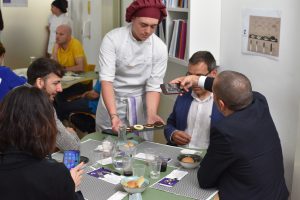The University of Siena participates in the GNAM project, winner of a cascade call in the PNRR area
Transforming the corporate museums of food companies from showcases to Living Labs in which different stakeholders, including producers and consumers, researchers and policy makers, co-create innovation actions towards sustainable food systems: this is the objective of the GNAM project, “Growing Novel food living lAbs in corporate Museums”.
The University of Siena is a partner of the project, coordinated by the University of Calabria, with GIAS, Rubbettino, Blec, Astorino Pasta, winner of a cascade call on the ONFOODS “Research and innovation network on food and nutrition Sustainability, Safety and Security” programme.

“Malnutrition is increasing worldwide especially for vulnerable social groups like children, elderly people, and low-income households” – explains Patrizia Marti, professor at the Department of Social, Political and Cognitive Sciences and scientific coordinator of the project for the University of Siena. “The lack of awareness of what constitutes a healthy meal, the limited purchasing power and the rising costs of food contribute to a higher risk of diet-related non-communicable diseases, with critical consequences on the healthcare systems. On the other side, the food companies struggle to be sustainable and competitive in the market, especially in some regions like in the Southern Italy. They need new strategies and partnerships to better cope with the effects of the economic and environmental crises”.
“The project GNAM – Marti continues – is motivated by the pressure to achieve sustainable food systems which are able to increase business opportunities, improve the health status of the population, and reduce inequalities in food security while addressing climate crisis (resources scarcity, pollution and waste, loss of biodiversity)”.
To address these challenges, the project GNAM will combine two recent trends: the corporate museums for social responsibility, exhibit-based facility managed by a business company, which collects and displays artefacts (e.g., prototypes, archive documents) to illustrate the history and achievements of the company, and the Living Lab model for technological and social innovations.
“Corporate museums – Marti says – are a contemporary phenomenon increasing in the last few years with a growing interest as tourism destinations and as means to promote the Made in Italy. While currently corporate museums act purely as a showcase for marketing purposes, they can also serve a social function for the benefit of the local community and society as a whole”.
 “The project GNAM – Marti adds – proposes to apply the organisational model of the Living Labs (LLs) to the corporate museums. The Living Labs constitute a community of stakeholders to foster open innovation in real-life environments based on co-creation activities. Acting as enabling environments, the Living Labs leverage a cooperation strategy between citizens, government, industry and academia”.
“The project GNAM – Marti adds – proposes to apply the organisational model of the Living Labs (LLs) to the corporate museums. The Living Labs constitute a community of stakeholders to foster open innovation in real-life environments based on co-creation activities. Acting as enabling environments, the Living Labs leverage a cooperation strategy between citizens, government, industry and academia”.
“The key principles of the Living Labs are: the creation of value at business, environmental and societal level; the empower the citizens who are not passive consumers to be educated, rather they become change makers; sustainability as a leading factor in promoting a positive impact on society and the planet” – Marti highlights.
“The Living Labs of GNAM – Marti continues – will organise a series of activities aimed at favouring collaborations among the stakeholders in four domains: technology transfer to experiment with advanced knowledge like 3D food printing to envision new food offering; education to offer learning experiences to consumers and professionals; innovation of products and services to experiment with new concepts, materials and technologies; communication to raise awareness and stimulate consumers’ habits towards healthy and sustainable nutrition”.
“When the corporate museums are transformed into Living Labs – Marti concludes – they are not just exhibition spaces to communicate the values of Made in Italy, rather they become environments to boost participatory open innovation”.

